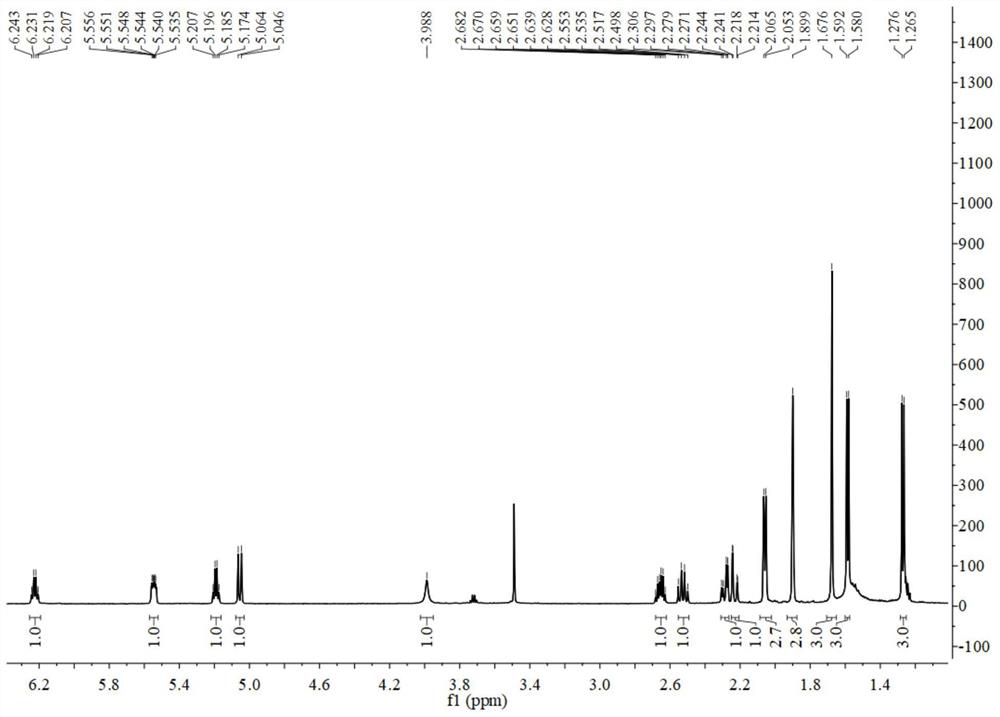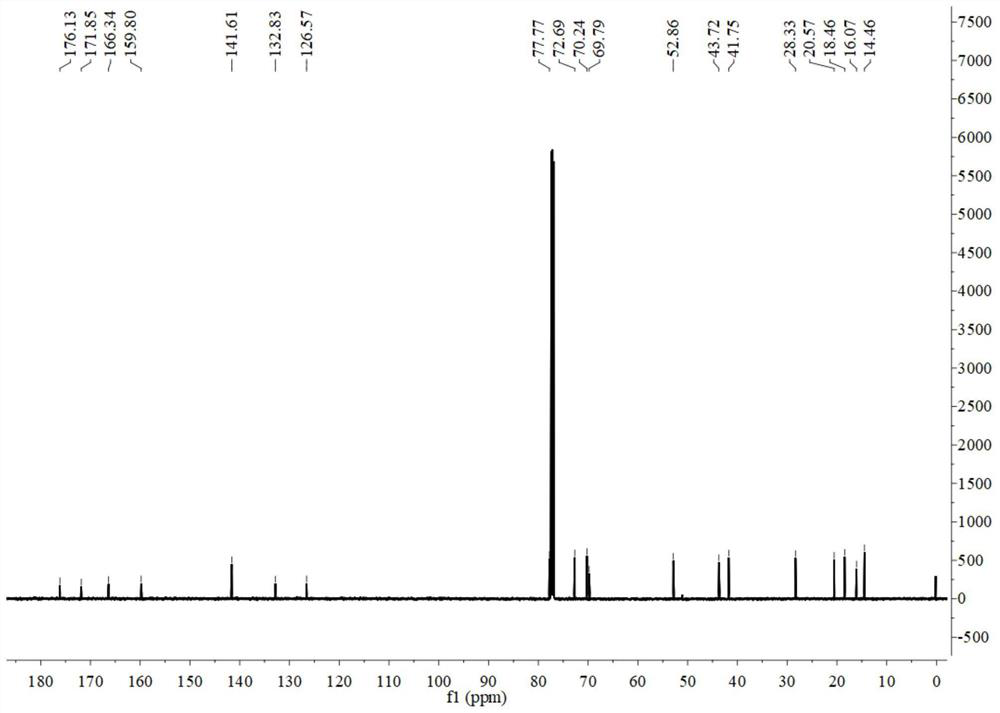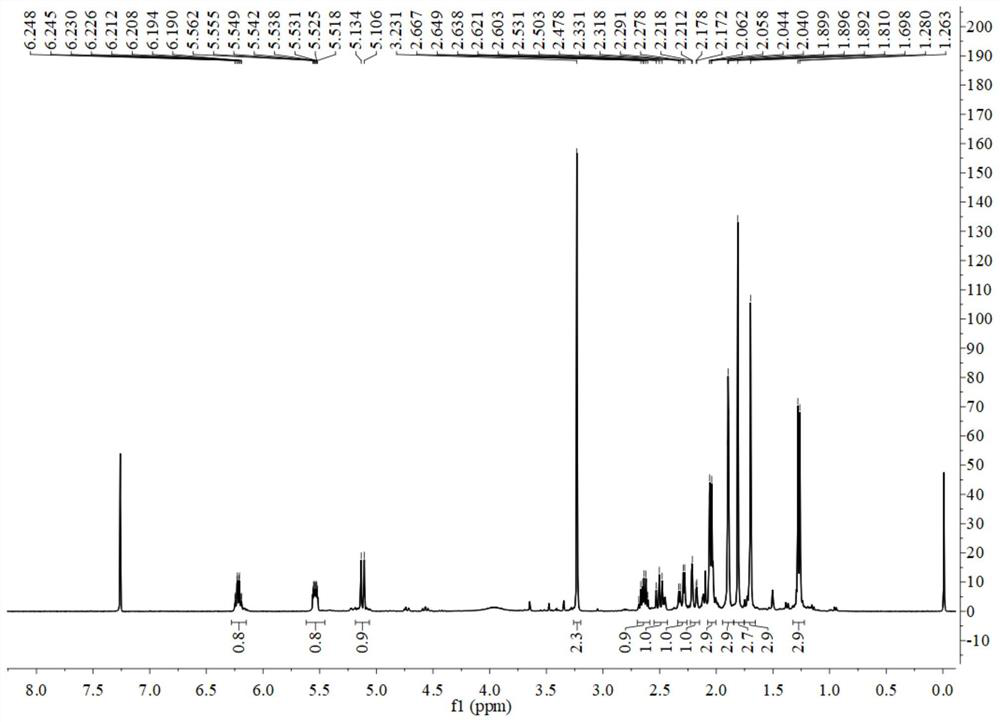Carbon-reducing guaiacane-type sesquiterpene lactone compound and preparation method thereof
An ester compound, guaiacane technology, applied in the field of medicine, can solve the problem of increasing the cytotoxicity of macrophages
- Summary
- Abstract
- Description
- Claims
- Application Information
AI Technical Summary
Problems solved by technology
Method used
Image
Examples
Embodiment 1
[0038] a. Take 5 kg of the whole yarrow herb, crush it, use 50 L of ethanol-water solution with a concentration of 50% to extract by cold soaking at room temperature, and evaporate the solvent to dryness under reduced pressure to obtain the crude extract of the whole yarrow plant;
[0039] b. Disperse the crude extract obtained in step a with water, add petroleum ether, ethyl acetate, and n-butanol to extract 3 times in sequence, combine the ethyl acetate layer and evaporate to dryness under reduced pressure to obtain the ethyl acetate layer extract extract;
[0040] c. The ethyl acetate layer extract extract obtained in step b is separated with a normal phase silica gel column, and gradient elution is carried out with petroleum ether-ethyl acetate with a volume ratio of 50:1-0:1, and the fraction passes through a silica gel thin layer For chromatographic analysis, the same fractions were combined to obtain 9 fractions F1-F9; fraction F4 was separated by Sephadex LH-20 gel colu...
Embodiment 2
[0042] a. Take 5 kg of whole yarrow herb, crush it, extract it with 40 L of ethanol-water solution with a concentration of 95% under reflux at 80° C., and evaporate the solvent to dryness under reduced pressure to obtain a crude extract of whole yarrow plant;
[0043] b. Disperse the crude extract obtained in step a with water, add n-hexane, dichloromethane and n-butanol successively to extract 4 times, combine the dichloromethane layers, and evaporate to dryness under reduced pressure to obtain the dichloromethane extract extract;
[0044] c. Separate the dichloromethane extract extract obtained in step b with a normal-phase silica gel column, carry out gradient elution with n-hexane-acetone with a volume ratio of 100:1-0:1, and analyze the flow points by silica gel thin-layer chromatography , combined the same fractions to obtain 9 fractions F1-F9; fraction F4 was separated by Sephadex LH-20 gel column, and eluted with chloroform-methanol with a volume ratio of 1:1 to obtain ...
Embodiment 3
[0046] a. Take 5 kg of the whole plant of Achillea miltiorrhiza, grind it and extract it by percolating with 40 L of absolute ethanol at room temperature, and evaporate the solvent to dryness under reduced pressure to obtain the crude extract of the whole plant of Achillea miltifolia;
[0047]b. Disperse the crude extract obtained in step a with water, add cyclohexane, ethyl acetate and n-butanol successively to extract 5 times, combine the ethyl acetate layers and evaporate to dryness under reduced pressure to obtain the ethyl acetate extract extract;
[0048] c. Separate the ethyl acetate extract extract obtained in step b with a normal-phase silica gel column, carry out gradient elution with cyclohexane-acetone with a volume ratio of 50:1-0:1, and flow through silica gel thin-layer chromatography Analysis, combined the same fractions to obtain 9 fractions F1-F9; fraction F4 was separated by ODS reverse-phase column, eluted with methanol-water solution gradient with a concent...
PUM
 Login to View More
Login to View More Abstract
Description
Claims
Application Information
 Login to View More
Login to View More - R&D
- Intellectual Property
- Life Sciences
- Materials
- Tech Scout
- Unparalleled Data Quality
- Higher Quality Content
- 60% Fewer Hallucinations
Browse by: Latest US Patents, China's latest patents, Technical Efficacy Thesaurus, Application Domain, Technology Topic, Popular Technical Reports.
© 2025 PatSnap. All rights reserved.Legal|Privacy policy|Modern Slavery Act Transparency Statement|Sitemap|About US| Contact US: help@patsnap.com



